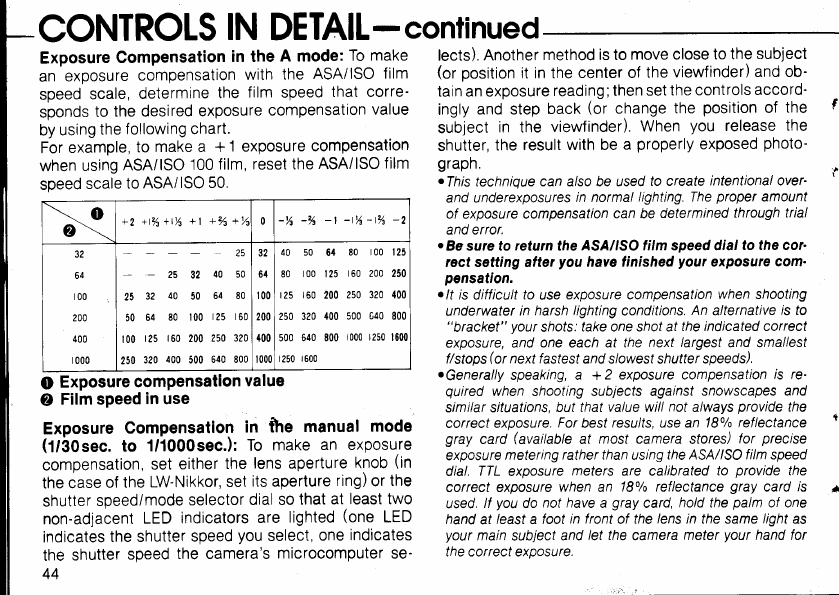
-CONTROLS
lN
DETA|L-confinued
Exposure
Compensation
in the
A mode:
To make
an exoosure
comoensation
with the
ASA/lSO
film
soeed
scale,
determine
the
film speed
that corre-
sponds
to
the desired
exposure
compensation
value
by
using
the
following chart.
For
example,
to
make a +
1 exposure
compensation
when
using
ASA/lSO
100
film, reset the
ASA/lSO
film
soeed
scale
to
ASA/lSO
50.
o
o
2
+t%+th
+1 +%+11
0
-% -%
-t -t% -t%
-2
3?
64
r00
200
400
| 000
25
32
40 50
25
32
40
50
64 80
50
64
80 100
l2s 160
100
125
160
200
?50 320
250
320
400
500
640 800
?5 32
64
r00
200
100
t000
40 50
64
80
r00
125
80
t00
t25
r60
200 250
t2s
r60
200
250 3?0 400
250 3?0 400
s00
640
800
s00 640 800
r000 r2s0
160(
r250 r600
O
Exposure
compensatlon
value
O
Film speed
in use
Exposure
Gompensatlon
in the
manual
mode
(tr3Osec.
to
1/1000sec.):
To
make
an exposure
compensation,
set either
the
lens aperture
knob
(in
the
case
of
the
LW-Nikkor,
set
its aperture
ring)or the
shutter
speed/mode
selector
dial so
that at
least two
non-adjacent
LED
indicators
are
lighted
(one
LED
indicates
the shutter
speed
you
select,
one
indicates
the
shutter
speed
the camera's
microcomputer se'
44
lects).
Another
method is to
move close
to the
subject
(or
position
it in the
center of
the
viewfinder)
and ob'
tain an exposure
reading; then
set
the controls
accord'
ingly
and step
back
(or
change
the
position
of
the
subject
in the
viewfinder).
When
you
release
the
shutter,
the
result with be
a
properly
exposed
photo-
grapn.
oThis
technique can a/so be used
to create
intentional over-
and underexposures
in normal
lighting. The
proper
amount
of exposure compensation
can be
determined
through trial
and error.
o
8e sure to
return
the
ASA/ISO lilm speed dial
to the cor-
rect setting after
you
have linished
your
exposurc
com-
pensation.
olt
is
difficult
to
use
exposure compensation
when shooting
underwater
in
harsh lighting
conditions.
An
alternative
is to
"bracket"
your
shots:
take one shot at
the indicated correct
exposure, and one each at
the
next largest
and smallest
f/stops
br
next
faslesl and s/owest s
hutter
speedd.
tGenerally
speaking, a +2
exposure compensation
is re-
quired
when shooting sublects against
snowscapes and
similar situations,
but that
value
will
not
always
provide
the
correct exposure.
For
best resu/ls, use an
180/o reflectance
gray
card
(available
at
most camera
stores)
for
precise
exposure
metering rather than using
the ASA//SO film speed
dial.
TTL
exposure
meters
are calibrated
to
provide
the
correct exposure
when
an
18o/o reflectance
gray
card
is
used.
lf
you
do
not have
a
gray
card,
hold the
palm
of one
hand
at
/east a foot
in f ront
of
the lens in the same
light
as
your
main
subject
and
let the
camera
meter
your
hand for
the correct exDosure.


















